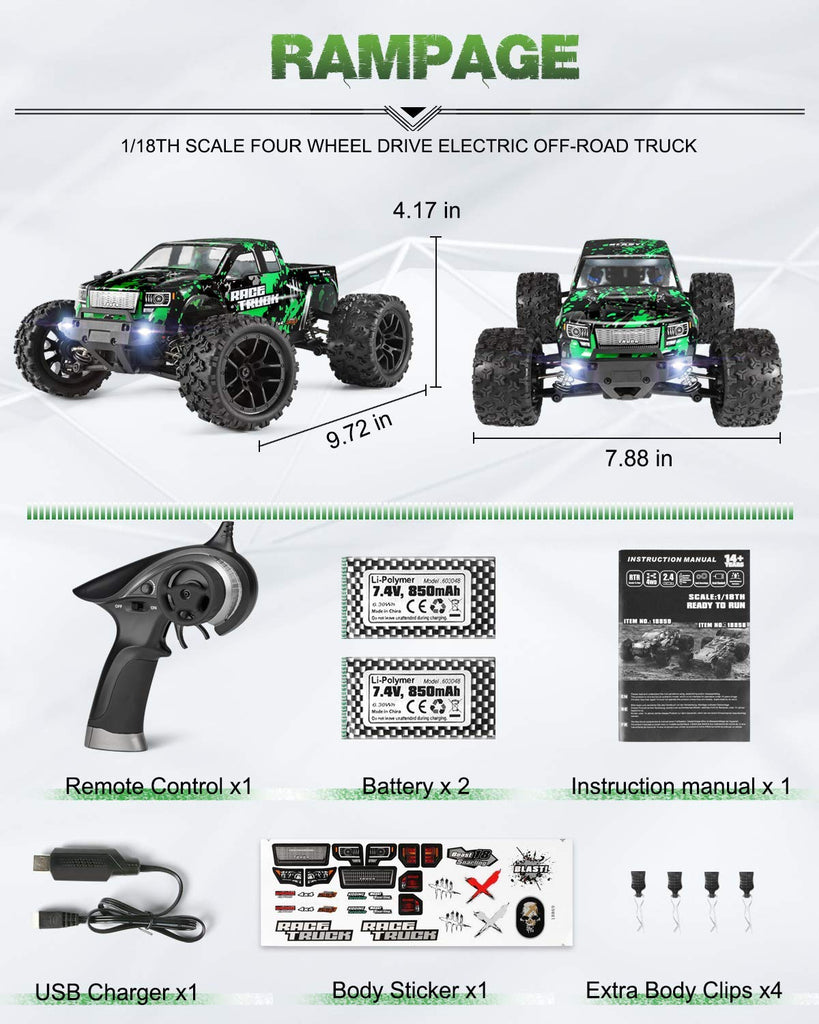送料無料HAIBOXING 1/18スケール 全地形RCカー 18859E 36KPH 高速4WD電気自動車 2.4GHzリモコン付き 4X4防水オフロードトラック 充電式バッテリー2個付並行輸入
(税込) 送料込み
商品の説明
商品情報
【全国送料無料】税関手続き及び関税の支払い等全て当ストアにて対応致します。海外輸入品の取り扱い特性上お届けまでに1~3週間程度お時間を頂く場合もございます。商品によりお届け期間は異なります。税関審査により開封及び外箱の損傷の可能性もございます、商品品質には問題ございませんのでご安心ください。ご不明点はお問い合わせよりお気軽にご連絡ください。(電波法上の技術基準に適合する必要がある無線機器をご購入ご検討の方へ→商品は並行輸入品のため電波法上の技術基準に適合しない場合がございます。日本国内でご使用する場合は電波法に違反する恐れがございますのでご購入やご使用には十分にご注意くださいませ)
14217円送料無料HAIBOXING 1/18スケール 全地形RCカー 18859E 36KPH 高速4WD電気自動車 2.4GHzリモコン付き 4X4防水オフロードトラック 充電式バッテリー2個付並行輸入ゲーム、おもちゃミニカーAmazon.com: HAIBOXING 1/18 Scale Brushless Fast RC Cars 18859AHAIBOXING 1:18 Scale All Terrain RC Car 18859, 36 KPH High Speed 4WD Electric Vehicle with 2.4 GHz Remote Control, 4X4 Waterproof Off-Road Truck with
HAIBOXING 1:18 Scale RC Monster Truck 18859E 36km/h Speed 4X4 Off Road Remote Control Truck,Waterproof Electric Powered RC Cars All Terrain Toys
HAIBOXING 1:18 Scale All Terrain RC Car 18859, 36 KPH High Speed 4WD Electric Vehicle with 2.4 GHz Remote Control, 4X4 Waterproof Off-Road Truck with
HAIBOXING 1:18 Scale All Terrain RC Car 18859, 36 KPH High Speed 4WD Electric Vehicle with 2.4 GHz Remote Control, 4X4 Waterproof Off-Road Truck with
HAIBOXING 1:18 Scale All Terrain RC Car 18859, 36 KPH High Speed 4WD Electric Vehicle with 2.4 GHz Remote Control, 4X4 Waterproof Off-Road Truck with
HAIBOXING 1:18 Scale All Terrain RC Car 18859, 36 KPH High Speed 4WD Electric Vehicle with 2.4 GHz Remote Control, 4X4 Waterproof Off-Road Truck with
HAIBOXING 1:18 Scale All Terrain RC Car 18859E, 36 KPH High Speed
HAIBOXING 1:18 Scale All Terrain RC Car 18859, 36 KPH High Speed 4WD Electric Vehicle with 2.4 GHz Remote Control, 4X4 Waterproof Off-Road Truck with
HAIBOXING 1/18 Scale Brushless Fast RC Cars 18859A, 4WD Off-Road Remote Control Trucks 48 KM/H Speed for Adults and Kids Boys, All Terrain Truck Toys
Amazon.com: HAIBOXING 1/18 Scale Brushless Fast RC Cars 18859A
Amazon.com: HAIBOXING 1/18 Scale Brushless Fast RC Cars 18859A
Amazon.com: HAIBOXING 1/18 Scale Brushless Fast RC Cars 18859A
Amazon.com: HAIBOXING 1/18 Scale Brushless Fast RC Cars 18859A
HAIBOXING 1:18 Scale All Terrain RC Car 18859, 36 KPH High Speed
Amazon.com: HAIBOXING 1/18 Scale Brushless Fast RC Cars 18859A
HAIBOXING RC Cars 1/18 Scale 4WD Off-Road Monster Trucks with 36+KM/H High Speed, 2.4 GHz Remote-Controlled Electric All Terrain Waterproof Vehicles
HAIBOXING 1:18 Scale RC Monster Truck 18859E 36km/h Speed 4X4 Off
HAIBOXING 1:18 Scale RC Monster Truck 18859E 36km/h Speed 4X4 Off Road Remote Control Truck,Waterproof Electric Powered RC Cars All Terrain Toys
HAIBOXING RC Cars, 1:18 Remote Control Car For Adults, 4wd High-Speed Hobby RC Truck 36km/h Fast RC Drift Car Waterproof Off-Road Electric RC Buggy
HAIBOXING 1:18 Scale RC Monster Truck 18859E 36km/h Speed 4X4 Off
Amazon.com: HAIBOXING 1:18 Scale All Terrain RC Car 18859, 36 KPH
Amazon.com: HAIBOXING 1:18 Scale RC Monster Truck 18859E 36km/h
HAIBOXING 1:18 Scale All Terrain RC Car 18859E, 36 KPH High Speed
Amazon.com: HAIBOXING 1:18 Scale RC Monster Truck 18859E 36km/h
HAIBOXING 1:18 Scale All Terrain RC Car 18859E, 36 KPH High Speed
HAIBOXING 1/18 Scale RC Cars 2196 Drift RC Car 28 KM/H High Speed with Gyro, 2.4 Ghz Electric Vehicle RTR 4X4 Remote Control Cars Drifting Race Toys
Amazon.com: HAIBOXING 1:18 Scale RC Monster Truck 18859E 36km/h
Amazon.com: HAIBOXING 1:18 Scale RC Monster Truck 18859E 36km/h
Amazon.com: HAIBOXING RC Cars 1/18 Scale 4WD Off-Road Monster
Amazon.com: HAIBOXING RC Cars, 1:18 Remote Control Car For Adults
Amazon.com: HAIBOXING RC Cars 1/18 Scale 4WD Off-Road
HAIBOXING 1:18 Scale RC Monster Truck 18859E 4X4 Off Road Remote Control Truck Reviewed
Amazon.com: HAIBOXING RC Cars, 1:18 Remote Control Car For Adults
Amazon.com: HAIBOXING 1/18 Scale RC Cars 2196 Drift RC Car 28 KM/H
HAIBOXING RC Cars 1 18 Scale 4WD Off Road Monster Trucks with 36
Amazon.com: HAIBOXING 1/18 Scale RC Cars 2196 Drift RC Car 28 KM/H
Amazon.com: HAIBOXING RC Cars, 1:18 Remote Control Car For Adults
HAIBOXING 1:18 Scale All Terrain RC Car 18859E, 36 KPH High Speed 4WD Electric review
HAIBOXING 1:18 Scale All Terrain RC Car 18859, 36 KPH High Speed
Amazon.com: HAIBOXING RC Cars 1/18 Scale 4WD Off-Road Monster
商品の情報
メルカリ安心への取り組み
お金は事務局に支払われ、評価後に振り込まれます
出品者
スピード発送
この出品者は平均24時間以内に発送しています







































